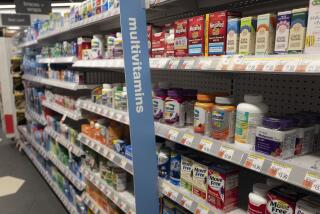With vitamin-enriched foods, more isnât always better
Her childbearing years are decades behind her, but Barbara Koblin, a 59-year-old L.A. business owner, still takes a prenatal multivitamin. She takes a handful of other supplements too, is careful about her diet and, at the supermarket, buys a few of those products enhanced with added vitamins and minerals.
âI just made the decision on my own that more is better,â Koblin says.
When it comes to some vitamins, however, too much of a good thing can be a bad thing. Itâs a warning that often comes with over-the-counter medications, but seldom with vitamin pills or the new generation of vitamin-charged foods that jostle for consumersâ attention.
Maybe it should, a special panel of experts said last week.
In a statement wrapping up three days of meetings outside Washington, D.C., a group of doctors, nutritionists and public health experts convened by the National Institutes of Health raised new safety concerns about vitamin supplements. With more than half of Americans taking multivitamins and a dramatic growth in the marketing of vitamin-fortified foods, the group said, âa growing proportionâ of Americans may be getting excessive amounts of some nutrients.
Convened to distill the âstate of the scienceâ on multivitamin use and safety, the 13-member panel warned that consumers who overdo it can face a wide range of risks, including liver poisoning and drug interactions that make prescribed medications work poorly. The panel cited studies that found as many as one in 10 consumers of multivitamins are overdosing on certain nutrients. Over the last eight years, some 30,000 reports of âadverse eventsâ associated with vitamin use have made their way through a federal government monitoring system.
Americans spend $23 billion a year on dietary supplements that include more than one vitamin or mineral. Meanwhile, orange juice is now marketed with a dizzying menu of added nutrients, cereals have been revved up with an array of added vitamins, and some water and soft drink labels now read like the side of a multivitamin bottle.
The Grocery Manufacturers Assn., which represents the nationâs largest makers of processed foods, has called âfunctional foodsâ -- including those with added vitamins and minerals -- âthe new frontierâ of grocery goods.
But Dr. J. Michael McGinnis, who chaired the federally sponsored conference, notes that nutritional supplements are âvirtually unregulatedâ and have not been studied with much rigor.
Panel members cited vitamin A, vitamin E, vitamin D, niacin, zinc, selenium and iron as nutrients for which safe upper limits can readily be exceeded by consumers whose diets are supplemented.
Furthermore, the rules that govern dietary supplement makers can make it hard to check their intake, the panel warned. By law, manufacturers of dietary supplements must list the minimum content of any included nutrients on the label of a multivitamin -- but the panel concluded that âhigher intakes are probable.â
Annette Dickinson, past president of the dietary supplement industry group Council for Responsible Nutrition, counters that the upper limits established for many nutrients are ânot a sharp edge,â but rather âa safe limit with quite a bit of cushion built into it.â Alison Kretzer of the Grocery Manufacturers Assn. says that for the many Americans who prefer not to buy or take vitamin pills, the new crop of vitamin-supplemented foods offers a great opportunity to improve nutrition without major extra cost.
She added that as a dietitian, she does âa little bit of mental mathâ before choosing a fortified product and will frequently choose the product without added nutrients. Speaking of many multivitamin users in the marketplace, Kretzer says, âI think theyâre probably doing that in their head.â
Says Dickinson: âPeople do have some responsibility to know what theyâre doing.â
For consumers such as Koblin, that may be a tall order. Well-read, health-conscious and highly motivated, Koblin acknowledges that she doesnât tote up her vitamin intake, saying sheâs often skeptical of what she reads on nutrition labels anyway.
âI have no idea Iâm doing the right thing, in all honesty,â Koblin says.
More to Read
Eat your way across L.A.
Get our weekly Tasting Notes newsletter for reviews, news and more.
You may occasionally receive promotional content from the Los Angeles Times.









